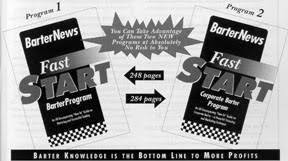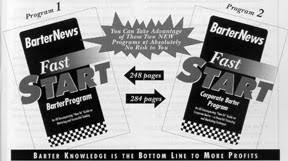Bob Meyer – Fast Start Barter System
$496.00 Original price was: $496.00.$58.90Current price is: $58.90.
Bartering is an age-old practice that has always been particularly common among businesses in small communities. File Size: 99.5 MB
Bob Meyer – Fast Start Barter System
Your children do it in school, just like when you were a kid. Remember? If you didn’t like what you found in your lunch box – say, a liverwurst sandwich or a carrot – you traded it for something more appealing. If lucky, you walked away with a cream-filled Ring Ding or a scarred rubber ball. Your kids, of course, are even smarter. They’re trading for more than their lunch, probably CD-ROMs, computer programs and the like; after all, it’s the value-charged, performance-minded ‘90’s – just like the “real” world of business, where bartering has gone big-time.Despite the views of some accountants, who occasionally advise that bartering could leave a client without enough incoming cash, businesses of all kinds are trading more than ever for various products and services. Indeed, bartering has become a business tool for thousands of companies, from restaurants to multi-billion-dollar corporations, who trade their products or services for some other nonmonetary asset. Even accountants themselves do it. Typically, companies trade what would otherwise become unused capacity for a regularly used item that otherwise would have cost cash. James Dee Johnson & Co., an eight person accounting firm in Oklahoma City, barters to mow its lawn, advertise its services and provide dental care to its entire staff. “We’ve utilized bartering through the economic ups and downs since 1983,” said the firm’s owner, James Dee Johnson.
Bartering is an age-old practice that has always been particularly common among businesses in small communities. But it has exploded in recent years into a sophisticated undertaking backed by a huge network of third-party players. Perhaps imbedded with the spirit of trade-savvy school kids, meanwhile, many business owners and executives have thrust bartering into a multi-billion-dollar industry that spans the globe. To it champions, bartering has become a vitally important tool for maximizing a company’s return on its assets while building a network of potential cash customers as well as trading partners. Bartering’s role in the performance strategies of businesses may have grown in significance during the recession of the late ‘80s and early ‘90s, when more and more businesses sought ways other than direct sales to maintain production and the inflow of supplies. Companies are “starting to understand how they can use their products and services as a form of capital to buy things they need,” said Bob Meyer, editor and publisher of Barter News, a quarterly trade journal.
“We operate a 70% capacity, but with barter it’s 90%,” said Shyka Cohen, owner of SCE Realty, a small real estate management firm in New York. In exchange for sending out its maintenance crews to paint and install sheet rock in other companies’ buildings, SCE earns trade dollars through Barter Advantage Inc., a local barter exchange, for purchasing business services it frequently uses, like printing and for employee benefits it could not otherwise afford, like dental and medical care.
UNLIMITED SELECTIONS:
The types of connections offered by bartering are virtually unlimited. To name just a sampling; Hotels unlock their rooms for advertising space in newspapers and magazines; printers roll their presses in exchange for legal services; manufacturers trade widgets for shares of another company’s stock; accountants offer tax preparation services for seats on airplanes; and employers of various kinds barter to provide incentives for employees, such as vacations at exotic resorts. “One of the nice things about bartering is that it enables you to be more generous with employees,” said Ken Mara, president of Worldwide Security salespeople who meet their fourth-quarter sales quotas, he noted, will receive Florida vacations, including airfare and luxury hotel accommodations – all paid for through bartering.
Get immediately download Bob Meyer – Fast Start Barter System
There are no hard and fast rules about who can trade for what. Much is done on an informal, bilateral basis, often depending on what’s available that willing traders need. Owen Freeman, a sole practitioner CPA in Anchorage, Alaska, expanded his business by doing payroll for a local restaurant for a monthly fee of $175. But rather than bill the restaurant for cash, Freeman and his wife regularly dine there and then square their tabs against the cost of the payroll services at the end of every month. The CPA said it works out well for all involved. “I usually end up owing them money every month,” he said. “It’s good food.”
Although no one can tell how much direct bartering is done in bilateral and unrecorded arrangements, the growth of organized bartering through hundreds of third-party exchanges has increased substantially in recent years, to nearly $9 billion in the U.S. alone.
According to the National Association of Trade Exchanges (NATE), “retail” bartering – involving products and services traded through third-party exchanges, mostly among small to mid-size companies of $10 million or less in annual sales-grew to $1.8 billion in 1994, up from $1.3 billion in 1992. “Corporate” bartering, which is generally regarded as the trading of bulk inventories by companies with sales of more than $10 million, reached $7 billion last year.
Although the value of goods traded through corporate exchanges dwarfs that of retail exchanges, the retail barter format exceeds its larger cousin in numbers of actual transactions and offers greater networking opportunities for members. While members of corporate exchanges, deal primarily through the exchange operator and may not even know who the other members are, the typical retail barter exchange offers direct connections with hundreds of member companies. The ability to interact with other retail exchanges opens members up to an estimated 250,000 companies that participate in them nationwide. “The biggest advantage (retail) barter offers is getting new business,” said Tom McDowell, executive director of the National Association of Trade Exchanges. After they begin bartering through a trade exchange, trading partners often develop a broader relationship that also includes referrals to each other for cash business. “When someone joins an exchange, they’re exposed to hundreds of thousands of potential clients.”
And the industry may be on the verge of astronomical growth worldwide. In the near future, the use of the Internet and other new software developments are expected to greatly enhance interaction among exchanges and their clients.
BARTERING GOES MAINSTREAM:
Bartering has also grown in stature as a reputable way of doing business. Although it still has its share of critics, third-party bartering through reputable exchanges is now considered a way of keeping everything above board and within government tax laws.“There were some shoddy barter exchanges in the past, but most of those have been weeded out,” said Kevin Andersen, a partner of the Salt Lake City accounting firm Andersen Andersen & Strong, which audits the books of a local trade exchange. “Now bartering is a credible industry.”The federal government, in fact, gave the barter industry a major boost in credibility through the Tax Equity and Fiscal Responsibility Act of 1982, which includes a provision that recognizes barter exchanges as third-party record keepers of financial information, much like banks or stock brokers. “It made our industry go from an underground economy to a legal form of business,” said Lois Dale, president of Barter Advantage Inc. in New York. “Members are not fearful of doing anything wrong.” Added Meyer, “Essentially, the barter industry has become an agent for the IRS.”
Third-party retail exchanges operate in a fiduciary role as a conduit between the exchange’s trading members, providing them with a form of currency, or “trade dollars,” that members can spend, as if the credits were actual cash, on any other products or services available from other members. The number of trade dollars a member receives is based on the value of the products or services it’s offering to trade; the value is determined by the members who are the buyer and seller. Indeed, since trade dollars are considered the same as cash for purposes of buying and selling within the exchange network, even “the IRS looks at them as if they are cash dollars,” said Mike Hartman, a partner with Chicago accounting firm Kach Hartman Ltd. and a trading member of the Chicago-based Illinois Trade Association. In other words, he and others said, any business expense that is tax deductible in cash form is also deductible if handled as barter.
BALANCING ACT:
One of the biggest challenges facing members of barter exchanges is maintaining a balance of trade dollars that is in the company’s best advantage. A good barter company will help its members maintain their trade dollar balance within a reasonable limit.
Even some accounting firms that regularly participate in barter exchanges warn that companies should carefully access whether bartering is right for them. “Bartering isn’t for every organization,” said Tom Burrill, a CPA who does the business tax returns for the Seattle-based barter exchange Cascade Trade Association, Inc.
For those that do barter, the National Association of Trade Exchanges suggests that a good rule of thumb is to use barter for about 5% to 7% of a company’s business.
At the same time, members should enter deals with other exchange members with the same level of scrutiny they would use in any business transaction. Although most exchanges try to limit their membership to reputable businesses, traders have to make the final decision.
ACCRUAL ACCOUNTING METHOD:
The IRS treats bartering accounts on an accrual basis, regardless of whether the taxpayer operates on the accrual or cash-based accounting method. The agency recognizes trade dollars as income as soon as they are credited to a company’s account, even though the company may not receive products or services for them until a later date. On the other hand, when trading for a business-related product or service through an exchange results in a negative balance of trade dollars – in other words, more products or services were received than paid for with trade dollars – the trader can claim a tax deduction for a business expense without having spent any cash.
TIMING IS IMPORTANT:
The best time to begin bartering varies with each individual company and depends largely on their ability to maintain a sizable cash flow. “I wouldn’t recommend barter for someone just starting out in business, unless they have sufficient capital backing,” said Jack Schacht, president of Chicago based Illinois Trade Association, which may be the single largest retail barter company, with nearly 4,000 members.
But bartering can fit into growth plans for companies that might not otherwise have the capital to expand. “If you’re on a limited budget and have to wait a year to print a brochure, bartering can give you that extra budget, said Dale. She added that when an accountant member of her exchange took on a partner and needed to quickly develop new business, she put him in touch with four companies that have since become regular accounting clients. “He increased his business without having to go out and sell himself,” she said.
Get immediately download Bob Meyer – Fast Start Barter System
Experienced traders will carefully monitor their level of bartering throughout the year, making sure that their balance of trade dollars doesn’t get too far on either the positive or negative side.
On the other hand, some traders let their balances build up in anticipation of a major or seasonal need. Worldwide Security will amass tens of thousands of trade dollars toward the end of the year in anticipation of a major advertising campaign its usually runs in the first quarter. “When I’m planning to put on a big blitz through a radio campaign, I start banking credits,” said Mara, noting that he barters with 10 broadcast stations.
MIXING BARTER AND CASH:
In retail barter exchanges, most transactions are done completely cashless. An exception will most likely occur in unusually large transactions, say, for $1 million worth of advertising. If a deal can’t be closed with that much in trade dollars, the two parties might agree to mix cash into the deal. “If companies cannot offer their products at 100% trade, they cannot be part of Cascade,” said President Steven White, noting that cash is included in only about 5% of the trades his company brokers. In corporate barter exchanges, where trades are generally done on a larger scale, cash is more commonly included.
NATURAL FOR ACCOUNTANTS:
The growth of bartering is happening at a good time for accountants, whose diversification into different practice areas coincides with a demand for various types of business services. “Accountants and attorneys are the bread and butter of barter exchanges,” said McDowell, adding, “As CPAs become more diversified, it brings more value to them in exchanges.” He added that many CPAs get involved in barter exchanges just to see how they work, often after hearing about them from clients. Once involved, “CPAs become some of our best members,” McDowell said. “They often have clients with excess inventory, and they recommend them.
Professional services firms also make good prospects for joining exchanges because their fixed operating and capital costs don’t usually increase through bartering. “We’re a natural for accounting firms,” said White.
BARTERING IN THE FUTURE:
Like many industries, bartering is caught up in pressures to become more efficient, faster and more wide spread. The National Association of Trade Exchanges along with many of the larger barter companies are looking at the Internet, improved software programs and modern technology, to make sure bartering plays the same important role in the future and the future of business.
Be the first to review “Bob Meyer – Fast Start Barter System” Cancel reply
Related products
Other Courses
Other Courses
Other Courses
Other Courses









![Penina Petersen – Freezer Meals 2: $1.50 Dinners – Veg Extras [eBook & Video Guides]](https://graspcourse.net/wp-content/uploads/2022/02/Penina-Petersen-–-Freezer-Meals-2-1.50-Dinners-–-Veg-Extras-eBook-Video-Guides-300x206.png)



Reviews
There are no reviews yet.